Heaters for Glass Cells
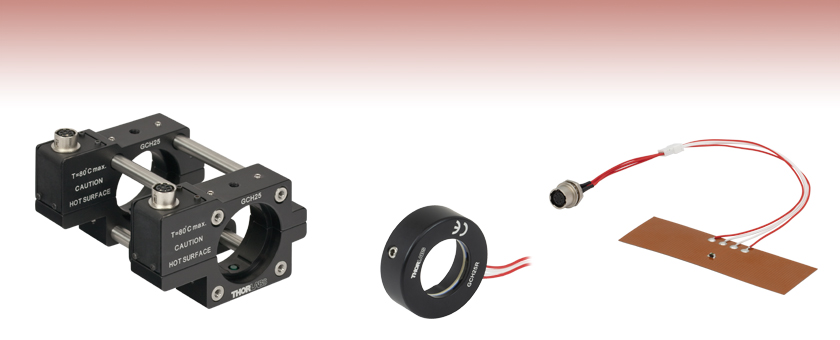
- Heaters for Glass Cells up to Ø25 mm
- Heating Capacity up to 15 W
- Integrated Thermistors for Closed-Loop Operation
- Compatible with Thorlabs' TC300 Heater Temperature Controller
GCH25-75
Heater Assembly for
Ø9, Ø19, or Ø25 mm Glass Cells,
30 mm Cage System Compatible
GCH25R
Cap Heater for
Ø25 mm Glass Cells
TLK-H
1" x 3" Flexible Foil Heater
for Ø25 mm Glass Cells

Please Wait
Features
- Heaters for Our Empty Glass Cells and Vapor Reference Cells
- Integrated Thermistors for Closed-Loop Temperature Control
- 30 mm Cage-System-Compatible Heater for Ø9 mm, Ø19 mm, or Ø25 mm Glass Cells
- Cap Heater with Setscrew Mounting for Ø25 mm Glass Cell Ends
- 1" x 3" Flexible Foil Heater with Adhesive Backing for Wrapping Around Ø12.7 mm and Ø25 mm Glass Cells
Thorlabs offers a variety of heaters for use with our vapor reference cells and empty glass cells : the GCH25-75 heater assembly features 15 W max heating capacity and is also compatible with our 30 mm cage system, the GCH25R cap heater is designed to be mounted on the end of Ø25 mm glass cells, and our flexible resistive foil heaters feature adhesive backing for attachment to glass cells or lens tubes. Each of these heaters is compatible with our TC300 Heater Temperature Controller.
| Compatible Single-Pass Cells Selection Guide | |||||||||
|---|---|---|---|---|---|---|---|---|---|
 |
 |
 |
 |
 |
 |
 |
 |
 |
|
| Empty Glass Cells with Borosilicate Windows | Glass Cells with Textured Antireflective Windows | Empty Glass Cells with Angled Windows | Empty Glass Cells with Brewster Windows | Empty Alumina Cells with Sapphire Windows | Threaded Empty Glass Cells | Vapor Reference Cells | Acetylene Reference Cells | Glass Cell Heaters | |
GCH25-75 Temperature Controller
TC200CAB10 Cable with 6-Pin, Male Hirose Connector
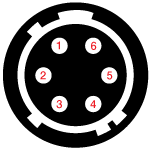
| Pin | Assignment |
|---|---|
| 1 | Heater Input |
| 2 | Heater Input Return |
| 3 | Reserved (Do Not Connect to This Pin) |
| 4 | Thermistor Input (+) |
| 5 | Thermistor Input Ground |
| 6 | Reserved (Do Not Connect to This Pin) |
TLK-H Heater with Thermistor and 6-Pin, Female Hirose Connector
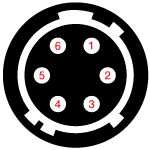
| Pin | Assignment |
|---|---|
| 1 | Heatera |
| 2 | Heatera |
| 3 | Not Connected |
| 4 | Thermistora |
| 5 | Thermistora |
| 6 | Not Connected |
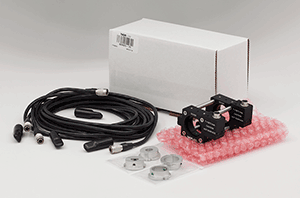
Click to Enlarge
GCH25-75 Packaging

| Item # | % Weight Reduction |
CO2-Equivalent Reductiona |
|---|---|---|
| GCH25-75 | 21.04% | 1.52 kg |
Smart Pack
- Reduce Weight of Packaging Materials
- Increase Usage of Recyclable Packing Materials
- Improve Packing Integrity
- Decrease Shipping Costs
Thorlabs' Smart Pack Initiative is aimed at waste minimization while still maintaining adequate protection for our products. By eliminating any unnecessary packaging, implementing packaging design changes, and utilizing eco-friendly packaging materials for our customers when possible, this initiative seeks to improve the environmental impact of our product packaging. Products listed above are now shipped in re-engineered packaging that minimizes the weight and the use of non-recyclable materials.b As we move through our product line, we will indicate re-engineered packages with our Smart Pack logo.
| Posted Comments: | |
Maria Romodina
(posted 2024-02-13 09:15:39.637) Dear Thorlabs team,
On the website the temperature limit for the GCH25-75 is 50°C, but on the unit it says 80°C maximum. Which recommendation should I follow and why is there such a big difference?
Kind regards,
Maria cdolbashian
(posted 2024-02-19 10:07:56.0) Thank you for reaching out to us with this inquiry. Since this device would be used in a heating setup, with our heater controller, the 50°C refers to the max temp you should operate this device, while the 80°C refers to the max setpoint which would be set in the controller's control panel (TC300 at the time of posting this). I have contacted you directly to expound on this further. |

| Specificationsa | |
|---|---|
| Heater Power | 15 W (Max) @ 24 V ± 20% 3.8 W @ 12 V 0.90 W @ 6 V |
| Max Temperature | 50 °C |
| Input Voltage | 24 VDC (Max) |
| Heater Resistance | 38.4 Ω (Typ.) |
| Connector Type | 6-Pin Hirose HR10A-7R-6S |
| Cable Length | 3 m (10 ft) |
| Simplified Drawing | |
| Compatible Controller | TC300b |
- Compatible with Ø25 mm Glass Cells
- Adapters for Ø9 mm or Ø19 mm Glass Cells
- 15 W Heating Power per Element (Two Elements per Assembly) with Thermistor
- Incorporates Hirose Connectors and Includes Cables for Use with TC300 Heater Temperature Controller
- Compatible with 30 mm Cage System
The GCH25-75 glass cell heater uses two built-in heating elements to raise the temperature of a vapor cell to as much as 50 °C (when room temperature is 25 °C; limited by the heater unit). The temperature is monitored using a Minco Thin Film Element sensor. Adapter rings for Ø9 mm and Ø19 mm cells are included. Without the use of adapters, the heater mounts Ø25 mm cells. This allows the heater to be used with our standard reference cells. The heater incorporates Ø6 mm cage rods and is compatible with our 30 mm cage system.
Thorlabs' TC300 Heater Temperature Controller (sold separately) is the ideal controller to maintain the heater temperature. Each heater ships with two Hirose cables to directly connect to the two output channels of the temperature controller. The two output channels allow for full operation of the reference cell heater using only one controller.

| Specifications | |
|---|---|
| Heater Power | 10 W (Max) ± 20% @ 24 V |
| Max Temperature | 50 °Ca |
| Input Voltage | 24 VDC (Max) |
| Heater Resistance | 50 Ω ± 10% |
| Connector Type | Bare Wire Leads |
| Lead Length | 305 mm (12.0") |
| Lead Length Tolerance | +10/-0.0 mm (+0.4/-0.0") |
| Simplified Drawing | |
| Compatible Controller | TC300b |
- Compatible with Ø25 mm Glass Cells
- Clear Aperture: 0.79" (20.0 mm)
- 10 W Heating Power with Thermistor
- Mounts Using Nylon-Tipped Setscrew with 5/64" (2.0 mm) Hex
The GCH25R cap heater is designed for use with Ø25 mm glass cells. It incorporates a metal ceramic heater, which is a 10 W ring-shaped heater with a 10 kΩ thermistor. The aluminum housing features a double bore with a nylon-tipped setscrew to hold it in place at the end of the cell. Two cap heaters (sold separately) may be used on opposite ends of the glass cell.
This heater features bare wire leads for use with a user-provided connector. The red leads of the heater are connected to the resistive heating element while the white leads are connected to the thermistor. A TC200CAB10 Hirose cable can be used to connect a GCH25R heater to the TC300 Heater Temperature Controller (each sold separately). For this purpose, the Hirose cable must be cut and wires exposed.

| Item # | HT10K | TLK-H |
|---|---|---|
| Heater Power | 10 W/in2 (0.016 W/mm2) @ 70 °C | |
| Heater Resistance | 19.7 Ωa | |
| Sensor Type | NTC10K Thermistor | |
| Size | 1" x 3" (25.4 mm × 76.2 mm) | |
| Effective Heating Area | 2.23 in2 (1438.7 mm2) | |
| Minimum Bend Radius | 0.5" (12.7 mm) in Thermistor Area, 0.030" (0.8 mm) in All Other Areas |
|
| Temperature Range | -32 to 100 °C (-26 to 212 °F) | |
| Connector Type | Bare Wire Leads | 6-Pin Hirose HR10A-7R-6S |
| Simplified Drawing and Pin Diagram |
||
| Compatible Controller | TC300b | |
- 1" x 3" Heating Area for Use with Glass Cells or Lens Tubes
- Adhesive Backing for Easy Installation
- 10 W/in2 Heating Power with Integrated Thermistors
- TLK-H Heater Incorporates Hirose Connectors for Use with TC300 HeaterTemperature Controller
These 1" x 3" (25.4 mm x 76.2 mm) foil heating elements are useful for many lab applications. They have an integrated thermistor for closed-loop temperature control and an acrylic pressure-sensitive adhesive backing for easy installation. Both models use the same Kapton (polyimide) heating element and 10 kΩ negative temperature coefficient (NTC) thermistor.
The HT10K features bare wire leads for use with a user-provided connector. Alternatively, the
Both foil heaters are flexible for use in applications such as heating lens tubes, as shown in the photo to the right. In this application, the lens tube can be isolated from the rest of the system using a Thermally Insulating Adapter.
 Products Home
Products Home












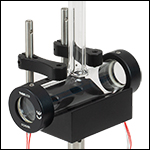
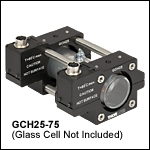
 Zoom
Zoom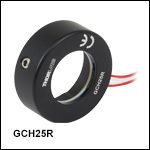
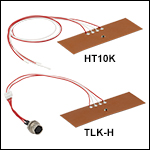
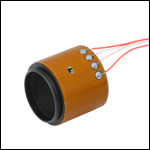
 Glass Cell Heaters
Glass Cell Heaters